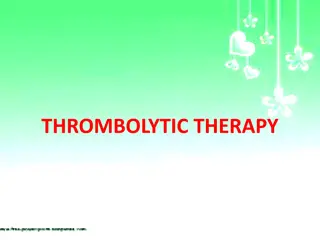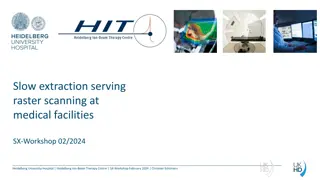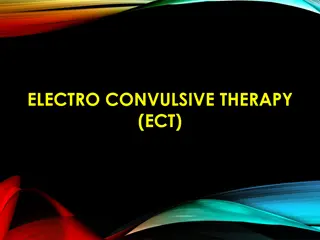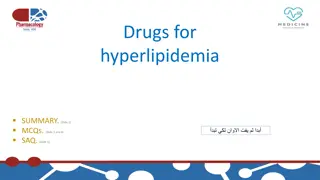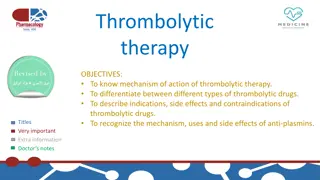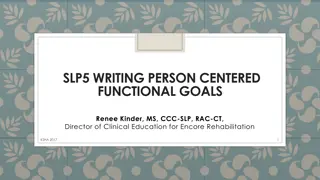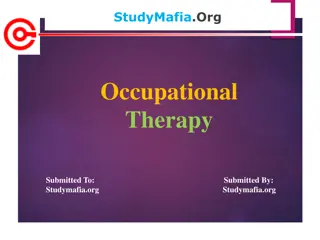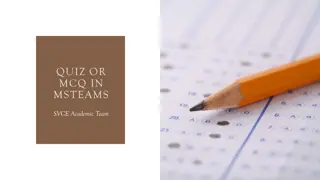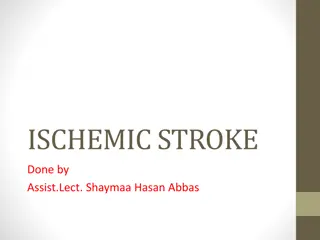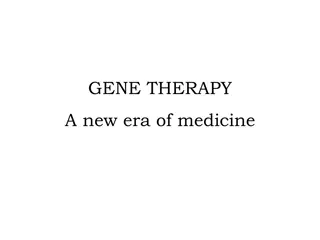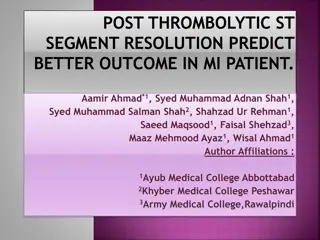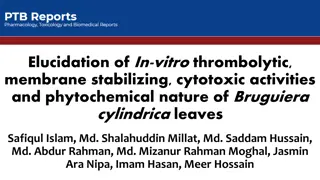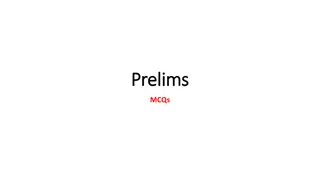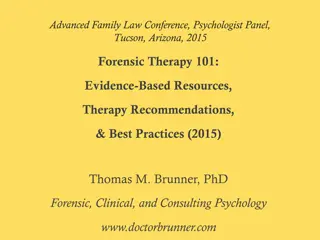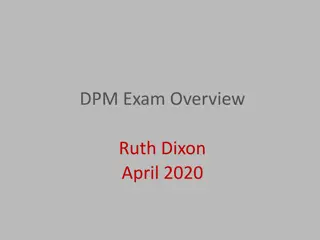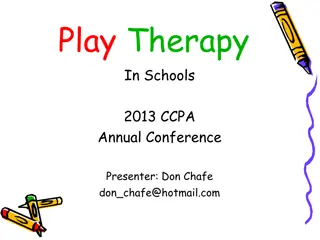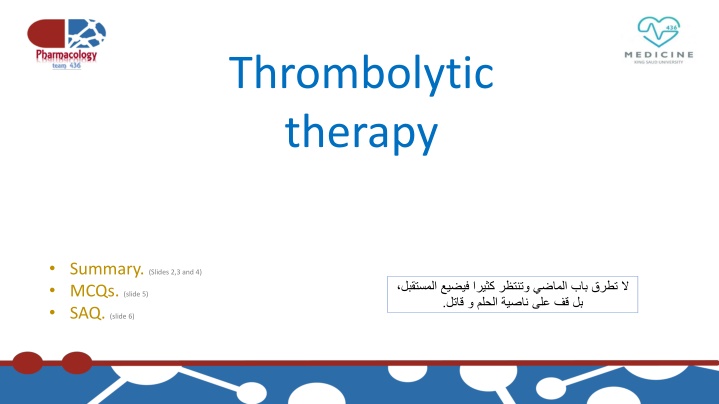
Thrombolytic Therapy: Mechanism, Agents, and Inhibitors
Explore the mechanism of thrombolytic agents, types of agents used, and inhibitors in thrombolytic therapy. Learn about fibrin-specific and non-fibrin-specific agents, their uses, side effects, and contraindications.
Uploaded on | 2 Views
Download Presentation

Please find below an Image/Link to download the presentation.
The content on the website is provided AS IS for your information and personal use only. It may not be sold, licensed, or shared on other websites without obtaining consent from the author. If you encounter any issues during the download, it is possible that the publisher has removed the file from their server.
You are allowed to download the files provided on this website for personal or commercial use, subject to the condition that they are used lawfully. All files are the property of their respective owners.
The content on the website is provided AS IS for your information and personal use only. It may not be sold, licensed, or shared on other websites without obtaining consent from the author.
E N D
Presentation Transcript
Thrombolytic therapy Summary. (Slides 2,3 and 4) MCQs. (slide 5) SAQ. (slide 6) .
Types of thrombolytic agents Thrombolytic agents: Drugs used to lyse already formed blood clot in clinical sittings where ischemia may be fatal. Mechanism of action of thrombolytic agents: They have common mechanism of action by stimulating activation of plasminogen via converting plasminogen to pro-enzyme to plasmin active enzyme which leads to lysis of the insoluble fibrin into soluble derivatives. Fibrin specific Non-fibrin specific Activate mainly plasminogen located on the surface of the clot. This group includes: - Alteplase. - Reteplase. - Tenecteplase. Activate plasminogen in general with no specificity to either free plasminogen or the plasminogen located on the surface of a clot. This group includes: - Streptokinase. - Anistreplase. - Urokinase. Types of thrombolytic agents: Thrombolytic agents produces there action by activation of plasminogen. How ever, the activation of free plasminogen could lead to a serious side effects like bleeding and to prevent that we had to make a new drugs that is fibrin specific which activate plasminogen located in an already formed colt with a little affinity to the free plasminogen. 2
Non-fibrin specific agents Streptokinase Anistreplase Urokinase Acts indirectly by forming streptokinase-plasminogen complex which then convert plasminogen to active plasmin. It is an anisoylated plasminogen- streptokinase complex and it s a prodrug. An human enzyme that is secreted form the kidney which is a direct plasminogen activator. Mechanism of action T less than 20 min. Given as IV infusion. Used in arterial and venous thrombosis. Longer duration of action. Greater clot selectivity. Given as IV bolus. Elimination t 12 to 20 min. Given IV infeusion. Used in acute massive pulmonary embolism. Pharmacokinetics and uses Antigenicity. Allergic reaction. Bleeding Should not be given to Patient with resent streptococcus infection. Previous administration of the drug. Side effects and contraindications Minimal fibrin selectivity. Expensive and to used nowadays. Fibrin specific agents Alteplase. Reteplase tenecteplase Another modified human t-PA. Prepared by recombinant DNA technology. Has t of more than 30 min. Can be administered as a single IV bolus. More fibrin-specific with longer duration of action. Approved only to be used in acute myocardial infarction. Is a recombinant form of human t-PA. Has a very short duration of action 5 min . It s usually administered as an intravenous bolus followed by an infusion. (60 mg IV bolus then 40 mg infusion over 2 hours). Used in: Elevation of ST segment. Pulmonary embolism A variant of recombinant t-PA. It has longer duration of action (15 min). Has enhanced fibrin specificity. Given as 2 IV bolus injections of 10 U each.(NO INFUSION) Used in: Elevation of ST segment. Pulmonary embolism. 3
Fibrinolytic Inhibitors (Antiplasmins) inhibit plasminogen activation and thus inhibit fibrinolysis and promote clot stabilization. Drug Aminocaproic Acid & tranexamic acid Aprotinin Mechanism Competitive Inhibition of Plasminogen Activation. inhibits fibrinolysis by blocking the action of plasmin (Plasmin antagonist). Administration Orally. Orally or IV. Adjuvant therapy in hemophilia. Postsurgical bleeding. Antidote for Fibrinolytic therapy-induced bleeding. Uses These drugs work like antidotes for fibrinolytic drugs. Similar to Protamine (Antidote of the anticoagulant, heparin) or Vitamin K (Antidote of the oral anticoagulant warfarin). 4
MCQs 1. Which id considered fibrin selective because it rapidly activate plasminogen that is bound to fibrin. A. Alteplase. B. Fondaparinux. C. Streptokinase. D. Urokinase. 4. Which one of the following has the longest duration of action? A. Urokinase. B. Anistreplase. C. Streptokinase. D. Tenecteplase. 5. Which of the following is a prodrug? A. Urokinase. B. Streptokinase. C. Tenecteplase. D. Anistreplase. 2. which of the following drugs is approved to be used in ST segment elevation with longer half-life? A. Urokinase. B. Alteplase. C. Reteplase. D. Anistreplase. 6. Which of the following is a relative contraindication for using thrombolytic agents? A. Major surgery within 2 weeks. B. Pulmonary fat embolism after multiple fraction. C. Severe uncontrolled hypertension. D. Active internal bleeding. 3. Streptokinase is a bacterial protein that is produced by: A. Alpha-hemolytic streptococci. B. Beta-hemolytic streptococci. C. Staphylococcus aureus. D. Escherichia coli. 7. Which one of the following can be used as antidote for warfarin? A. Aminocarpoic acid. B. Aprotinin. C. Protamine. D. Vitamin K. 4. Which is can t be used in patient with previous streptococcal infection? A. Streptokinase. B. Anistreplase. C. Urokinase. D. A and B. D 8. C 7. D 6. B 5. D 4. B 3. C 2. A 1. Answers: 5
A 66-year-old man presents to the emergency room with 10/10 substernal chest pain, and pressure radiating into his jaw that has been occurring for the last six hours. He has a history of coronary artery disease, hypertension, diabetes, and dyslipidemia. After examination the ECG shows ST segment elevation. They diagnosed him with ST segment elevation Myocardial infarction. Q1: What is the drug of choice in this situation? All tissue plasminogen activator can be used specially tenecteplase because it s approved to be used in such an acute situation. Q2: What is the mechanism of action of this drug? It s a tissue plasminogen activator which is fibrin specific that works by activating plasminogen bound to the clot surface. Q3: What is the time frame should this drugs be administered in and why? 4 hours. Because the clot get resistant to the thrombolytic agents with aging and there will be a massive tissue damage which that can t be reversible with the reperfusion. Q4: List 3 absolute contraindication of thrombolytic agents. Intracranial hemorrhage. Major surgery with 2 weeks. Active internal bleeding. Q5: Write ONE major advantage of fibrin specific thrombolytic over non-fibrin specific agents. Less affinity to systemic circulating plasminogen which makes the risk of bleeding much less. 6
Revised by: Done by: Ghadah Almuhana Abdulrahman Thekry Contact us : @Pharma436 Pharma436@outlook.com

